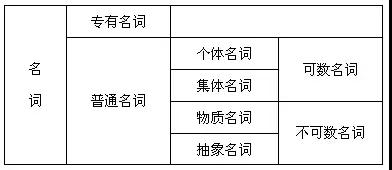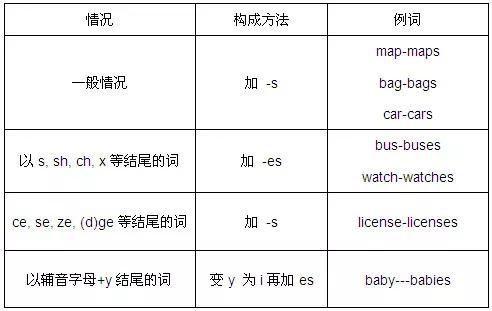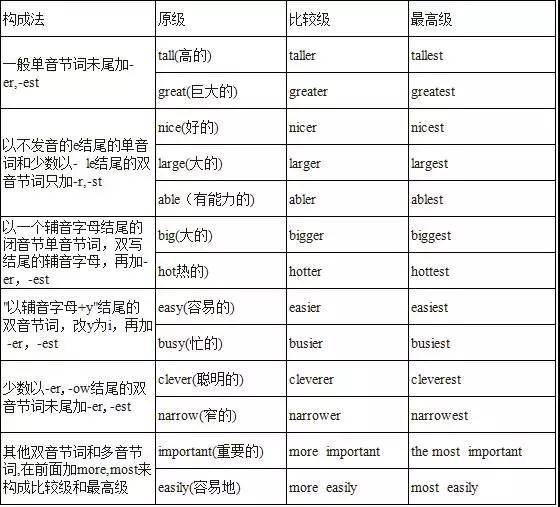
今天整理了
01
词性的分类
词类又叫词性,
1.名词 noun n. student 学生
2.代词 pronoun pron. you 你
3.形容词 adjective adj. happy 高兴的
4.副词 adverb adv. quickly 迅速地
5.动词 verb v. cut 砍、割
6.数词 numeral num. three 三
7.冠词 article art. a 一个
8.介词 preposition prep. at 在...
9.连词 conjunction conj. and 和
10.感叹词 interjection interj. oh 哦
前六类叫实词,后四类叫虚词。下面就一一介绍
02
名词

名词复数的规则变化

名词的格
在
名词所有格的规则如下:
1)单数名词词尾加“'s”,复数名词词尾没有s,也要加“'s”,如the boy‘s bag 男孩的书包,men’s room 男厕所。
2)若名词已有复数词尾-s ,只加“'”,如:the workers’ struggle工人的斗争。
03
代词
大多数代词具有名词和形容词的功能。
人称代词的用法
I saw her with them,at least, I thought it was her.我看到她和他们在一起,至少我认为是她。(her做宾语,them做介词宾语,her作主补)
a. -- Who broke the vase?--谁打碎了花瓶?
b. -- Me.--我。
并列人称代词的排列顺序
1) 单数人称代词并列作主语时,其顺序为:

如:You, he and I should return on time.
2) 复数人称代词作主语时,其顺序为:

反身代词


指示代词
指示代词分单数(this / that)和复数(these / those)两种形式,既可作限定词又可做代词
疑问代词
指人:who, whom, whose
指物: what
既可指人又可指物: which
04
冠词
冠词是位于名词或名词词组之前或之后,在句子里主要是对名词起限定作用的词。冠词是一种虚词。
不定冠词a (an)与数词one 同源,是“一个”的意思。
定冠词的用法
定冠词the与指示代词this,that同源,有“那(这)个”的意思。
1)特指双方都明白的人或物:Take the medicine.把药吃了。
2)上文提到过的人或事: He bought a house. I’ve been to the house.
3)指世上独一物二的事物:the sun,the sky,the moon,the earth(敲黑板,这个是经常会在选择题中考到的知识点)
4)单数名词连用表示一类事物,如:the dollar 美元;the fox 狐狸;
5)用在序数词和形容词最高级,及形容词only,very, same等前面:
Where do you live? I live on the second floor.你住在哪?我住在二层。
6)与复数名词连用,指整个群体:
They are the teachers of this school.指全体
They are teachers of this school.(指部分
7)用在专有名词前:
the People‘s Republic of China中华人民共和国
8) 用在姓氏的复数名词之前,表示一家人:the Greens格林一家人 (或格林夫妇)
05
数词
表示数目多少的数词叫基数词;表示顺序的数词叫序数词。序数词表示排列的顺序
序数词的缩写形式为阿拉伯数字加序数词的最后两个字母。
如: first---1st; second---2nd; third-3rd;
基数词变序数词的巧记口诀
一二三要全变(one-first; two-second;three- third)
其余都加th, th里有例外
8去t,(eight-eighth) 9去e(nine-ninth)
字母f代ve(five-fifth; twelve-twelfth);
ty变成tie(twenty-twentieth)
若要变化几十几,只变个位就可以(twenty-one-twenty-first)
数词的用法
1)倍数表示法
a. 主语+谓语+倍数(或分数)+ as + adj. + as
I have three times as many as you.我有你三倍那么多。
b. 主语+谓语+倍数(分数)+ the size (amount,length…) of…
The earth is 49 times the size of the moon.地球是月球的49倍。
c. 主语+谓语+倍数(分数)+ 形容词(副词)比较级+ than…
The grain output is 8 percent higher this year than that of last year.
d. 还可以用by+倍数,表示增加多少倍
The production of grain has been increased by four times this year.
2)分数表示法
构成:基数词代表分子,序数词代表分母。分子大于1时,分子的序数词用单数,分母序数词用复数:1/3 one-third ; 3/37 three and three-sevenths
06
形容词及其用法
主要用来修饰名词的词,表示事物的特征。
形容词用来修饰名词或代词,表示人或事物的性质、状态,和特征的程度好坏,与否。
形容词作定语修饰名词时,要放在名词的前边。但是如果形容词修饰以-thing为字尾的词语时,要放在这些词之后,例如:something nice
以-ly结尾的形容词
1)friendly,deadly,lovely,lonely,likely,lively,ugly,brotherly,仍为形容词。
2)有些以-ly 结尾既为形容词,也为副词。
daily,weekly,monthly,yearly,early
The Times is a daily paper. The Times is published daily.
用形容词表示类别和整体
某些形容词加上定冠词可以泛指一类人,与谓语动词的复数连接。
如:the dead,the living,the rich,the poor,the blind,the hungry
07
副词及其基本用法
副词(adverb,简写为adv)是一种用来修饰动词、形容词、全句的词,说明时间、地点、程度、方式等概念的词。副词是一种半虚半实的词。
副词可分为:地点副词、方式副词、程度副词、疑问副词和连接副词。
兼有两种形式的副词
1) close与closely
close意思是“近”; closely 意思是“仔细地”
He is sitting close to me. Watch him closely.
2)late 与lately
late意思是“晚”; lately 意思是“最近”
You have come too late.What have you been doing lately?
形容词与副词的比较级
大多数形容词(性质形容词)和副词有比较级和最高级的变化,即原级、比较级和最高级,用来表示事物的等级差别。原级即形容词的原形,比较级和最高级有规则变化和不规则变化两种。
1) 规则变化

2) 不规则变化
有少数形容词、副词的比较级和最高级是不规则的,必须熟记。如:
good→ better→ best
well→ better→ best
bad→ worse→ worst
ill→ worse→ worst
old→ older/elder→ oldest/eldest
many/much→ more→ most
little→ less→ least
far→ further/farther→ furthest/farthest
08
动词
动词根据其后是否可直接跟宾语,可分为两类,分别是:及物动词(可直接跟宾语)、不及物动词(不能直接跟宾语,若要跟宾语,必须加上某个介词)。
系动词
1)状态系动词:用来表示主语状态,只有be一词,例如:He is a teacher.
2)持续系动词:用来表示主语继续或保持一种状况或态度,主要有keep,rest,remain,stay,lie,stand
例如:He always kept silent at meeting.
他开会时总保持沉默。
3)表像系动词:用来表示“看起来像”这一概念,主要有seem,appear,look
例如:He looks tired.他看起来很累。
4)感官系动词:感官系动词主要有feel,smell,sound,taste
例如:This kind of cloth feels very soft.
This flower smells very sweet.
5)变化系动词:这些系动词表示主语变成什么样,变化系动词有become,grow,turn,fall,get,go,come,run
例如:He became mad after that.自那之后,他疯了。
6)终止系动词:表示主语已终止动作,主要有prove,turn out,表达“证实”,“变成”之意
例如:The search proved difficult.搜查证实很难。
09
连词
连词是一种虚词, 它不能独立担任句子成分而只起连接词与词,短语与短语以及句与句的作用。
连词主要可分为两类:并列连词和从属连词。
并列连词用来连接平行的词、词组和分句。如:
and,but,or,nor,so,therefore,yet,however,for, hence,as well as,both…and,not only…but also, either…or,neither…nor, (and)then等等。
比较so和 such
such是形容词,修饰名词或名词词组。
so是副词,只能修饰形容词或副词。so 还可与表示数量的形容词many,few,much, little连用,形成固定搭配。
so + adj. such + a(n) + n.
so + adj. + a(n) + n. such + n. (pl.)
so + adj. + n. (pl.) such +n. (pl.)
so + adj. + n. [不可数] such +n. [不可数]
so foolish ;such a fool
so nice a flower;such a nice flower
so many/ few flowers;such nice flowers
so much/little money;such rapid progress
so many people ;such a lot of people
10
介词
介词是一种用来表示词与词、词与句之间的关系的虚词,在句中不能单独作句子成分。
介词后面一般有名词代词或相当于名词的其他词类,短语或从句作它的宾语。
介词和它的宾语构成介词词组,在句中作状语,表语,补语或介词宾语。
介词的分类
地点(位置、范围)介词
above在…前,about在…附近,across在…对面,after在…后面,against倚着...,along在…近旁,among在…中间,around在…周围,round在….周围,at在…处,before在...前,behind在...后,below低于..., beside在...旁边,between在...之间,by在...旁,down在...下面,from来自...,in在...里面,inside在...里面,等等。
方向(目标趋向)介词
across横越...,against对抗..., along沿着...,around绕着...,round环绕...,at朝着...,behind向…后面,between…and…从…到...,by路过/通过...,down向…下,for向..., from从/离..., in进入..., into进入...,inside到...里面, near接近...,off脱离/除...,on向...上,out of向...外,outside向....外,over跨过...,past经过/超过...,through穿过...,to向/朝...,towards朝着...,on to到...上面,onto到...上面, up向...上,away from远离...
时间介词
about大约...,after在…以后,at在… (时刻),before在…以前,by到…为止,during在…期间,for有…(之久),from从…(时)起,in在(上/下午),在(多久)以后,on在(某日),past过了…(时),since自从…(至今), through 贯穿…(期间),till直到…时, until直到…时,to到(下一时刻),ever since从那时起至今,at the beginning of在...开始时,at the end of在...末 ,in the middle of在...当中,at the time of在...时
方式介词
as作为/当作...,by用/由/乘坐/被..., in用…(语言),like与…一样,on骑(车)/徒(步),通过(收音机/电视机), over通过(收音机),through通过...,with用(材料),用(手/脚/耳/眼), without没有…
涉及介词
about关于...,except除了…,besides除了…还... for对于/就…而言,in在…(方面),of…的,有关...,on关于/有关...,to对…而言,towards针对...,with就…而言
其它介词
目的介词:for为了...,from防止…,to为了…
原因介词:for因为...,with由于…,because of因为...
比较介词:as与…一样,like象…一样,than比...,to与…相比,unlike与…不同(图片来源于网络,如有侵权请联系删除。)
 高招云直播
高招云直播




